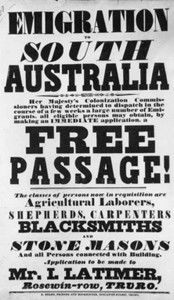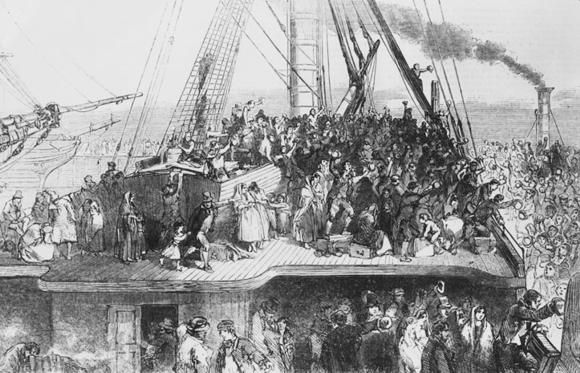Emigration from England to South Australia in the 1800s
The “Mayflower” is ‘the ship’ in US history. The first ship to transport passengers from England to the United States in 1620. 102 people, all hoping to start a new life on the other side of the Atlantic.
 Well, in South Australian history the “Buffalo” is the equivalent. It was one of a fleet of ships to arrive in the colony at the end of 1836. Once it arrived at Glenelg, Governor John Hindmarsh who was on board, proclaimed the establishment of government in South Australia as a British province.
Well, in South Australian history the “Buffalo” is the equivalent. It was one of a fleet of ships to arrive in the colony at the end of 1836. Once it arrived at Glenelg, Governor John Hindmarsh who was on board, proclaimed the establishment of government in South Australia as a British province.
From then on, there was a big push to get skilled labourers from England to emigrate to the new colony, and as an enticement they were offered free passage (assisted passage). Of course there was still the option for anyone who wished to emigrate to pay their own way (known as unassisted passage), but many took up the offer of the emigration scheme, and as a result these pioneers helped make South Australia what it is today.
But as with anything that’s free, there were some rules and regulations.
I came across this list of rules for those wanting assisted passage in the West Briton and Cornwall Advertiser, dated 27 February 1839, and it’s truly fascinating.
RULES FOR EMIGRATION
- The Act of Parliament declares that the whole of the funds arising from the sale of lands, and the rent of pasture, shall form an Emigration Fund, to be employed in affording a free passage to the Colony from Great Britain and Ireland for poorer persons; “provided that they shall, as far as possible, be adult persons of both sexes in equal proportions, and not exceeding the age of 30 years.”
- With a view to carrying this provision into effect, the Commissioners offer a free passage to the Colony (including provisions and medical attendance during the voyage) to persons of the following description.
- Agricultural laborers, Shepherds, Bakers, Blacksmiths, Braziers, and Tinmen, Smiths, Shipwrights, Boat-builders, Butchers, Wheelwrights, Sawyers, Cabinetmakers, Coopers, Curriers, Farriers, Millwrights, Harness-makers, Lime-burners, and all persons engaged in the erection of buildings.
- Persons engaged in the above occupations, who may apply for a free passage to South Australia, must be able to give satisfactory references to show that they are honest, sober, industrious, and of general good character.
- They must be real laborers, going out to work for wages in the colony, of sound mind and body, not less than 15, nor more than 30 years of age, and married. The Marriage Certificate must be produced. The rule as to age is occasionally departed from in favour of the parents of large families.
- To the wives of such laborers as are then sent out, the Commissioners offer a free passage with their husbands.
- To single women a free passage will be granted, provided they go out under the protection of their parents, or near relatives, or under actual engagement as servants to ladies going as cabin passengers on board the same vessel. The preference will be give to those accustomed to farm and dairy work, to seamstresses, strawplatters, and domestic servants.
- The children of parents sent out by the Commissioners will receive a free passage, if they are under one, or fall 15 years of age at the time of embarkation. For all other children £5 each must be paid before embarkation by their parents or friends, or by the Parish. It will be useless to apply for a relaxation of this rule.
- Persons who are ineligible to be conveyed out by the Emigration Fund, if not disqualified on account of character, will be allowed to accompany the free Emigrants on paying to the commissioners the bare contract price of passage, which is usually between £15 and £17 for each adult person. The charges for children are as follows: under one year of age, no charge; one year of age but under seven, one-third of the charge for adults; seven years of age and under fourteen, one-half the charge for adults. A passage intermediate between a cabin and steerage passage may also be obtained of the Commissioners at a cost exceeding that of the steerage passage by one-half. Each intermediate passenger is entitled to half a cabin with some slight comforts in addition to those enjoyed by the steerage passengers.
- All Emigrants, adults as well as children, must have been vaccinated.
- Emigrants will, for the most part, embark at the Port of London, but if any considerable number should offer themselves in the neighbourhood of any port of Great Britain or Ireland, arrangement will, if possible, be made for their embarkation at such port.
- The expense of reaching the port of embarkation must be borne by the emigrants, but on the day appointed for their embarkation, they will be received, even though the departure of the ship should be delayed, and will be put to no further expense.
- Every adult Emigrant is allowed to take half-a-ton weight or twenty measured cubic feet of baggage. Extra baggage is liable to charge at the rate of £2.10s the ton.
- The Emigrants must provide the bedding for themselves and children, and the necessary tools of their own trades; the other articles most useful for emigrants to take with them, are strong plain clothing, or the materials for making clothes upon the passage. In providing clothing, it should be remembered that the usual length of the voyage is about four months.
- On the arrival of the Emigrants in the colony, they will be received by an Officer, who will supply their immediate wants, assist them in reaching the place of their destination, be ready to advise with them in case of difficulty, and at all times give them employment at reduced wages on the Government works, if from any cause they should be unable to obtain it elsewhere. The Emigrants will, however, be at perfect liberty to engage themselves to any one willing to employ them, and will make their own bargain for wages. This arrangement, while it leaves the Emigrant free to act as he may think right, manifestly renders it impossible for the Commissioners to give any exact information as to the amount of wages to be obtained; they can merely state that hitherto wages have been very much higher than in England.
So a free passage together with the social and economic conditions in England at the time, enticed our ancestors to pack up their whole life, spend four months on board a ship, travelling to an unknown country on the other side of the world, to start start again. We can’t imagine it can we.
The pioneers. They were brave beyond our understanding.





